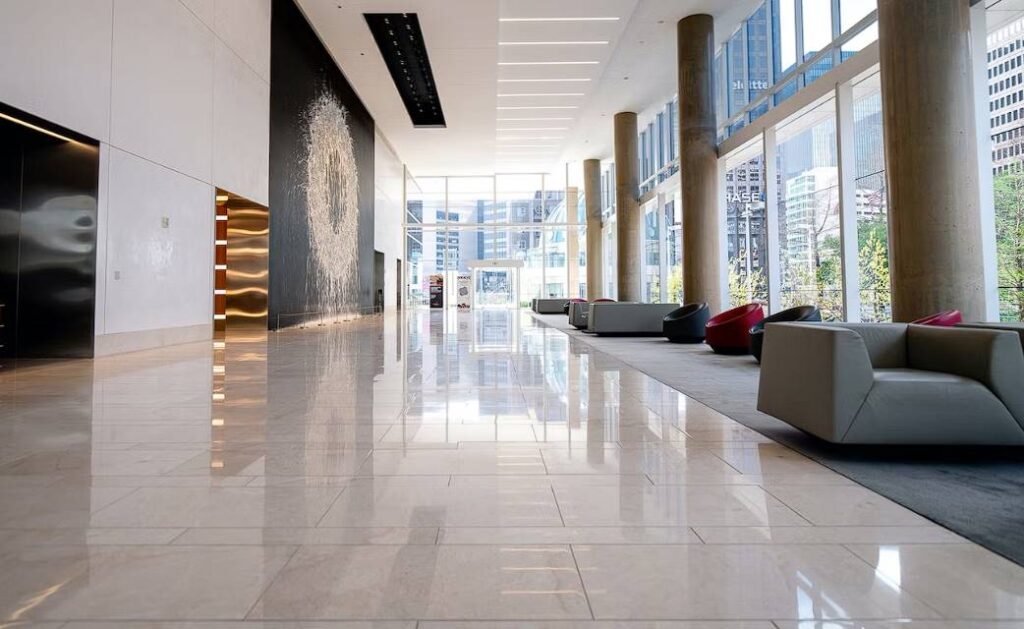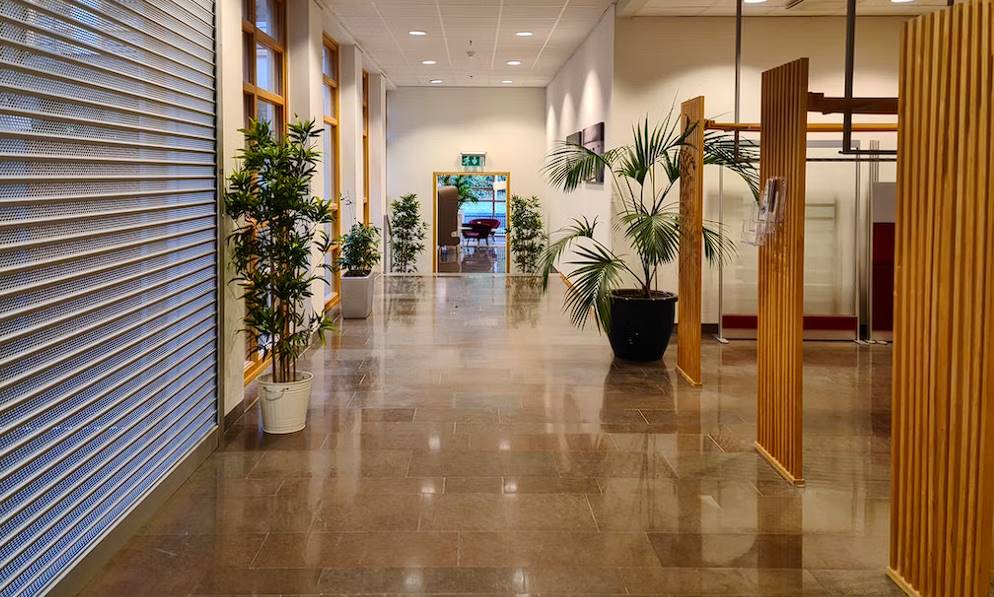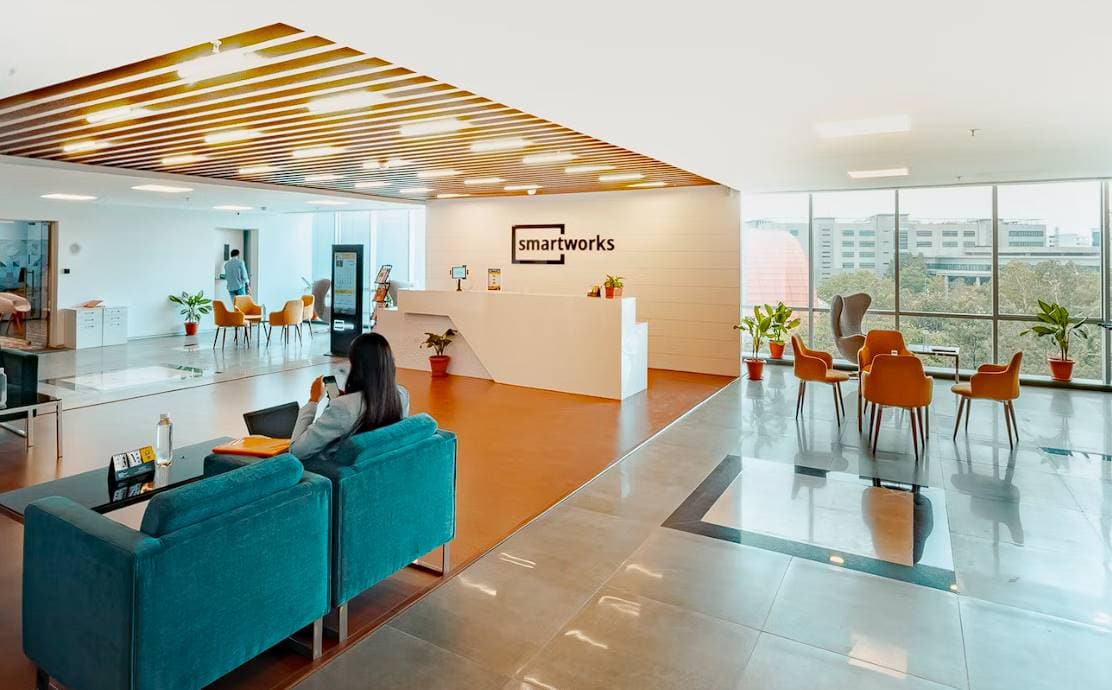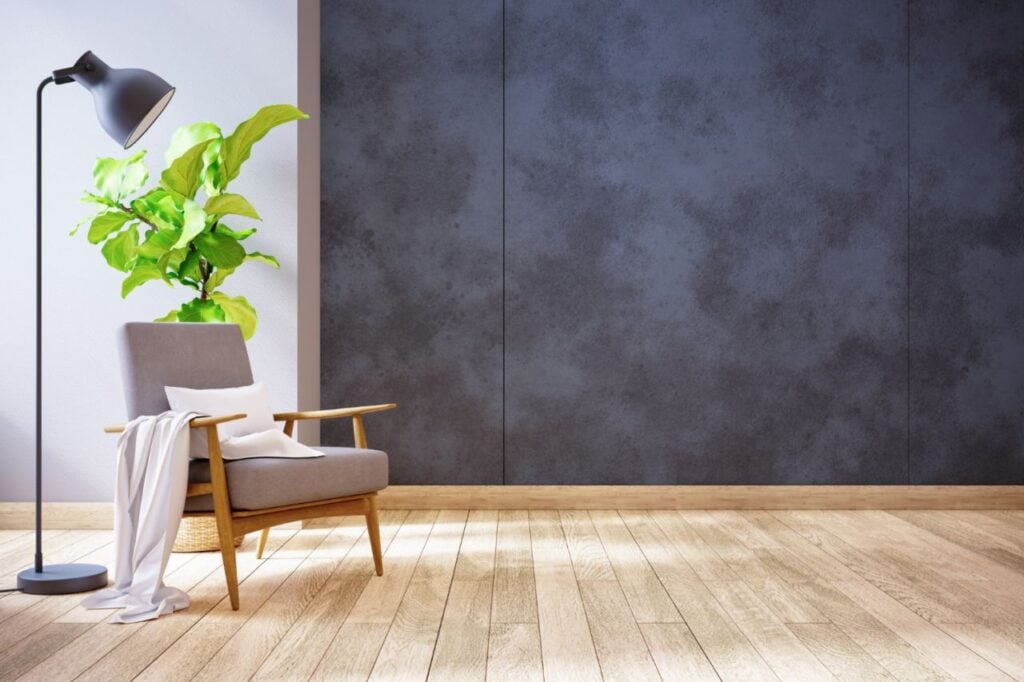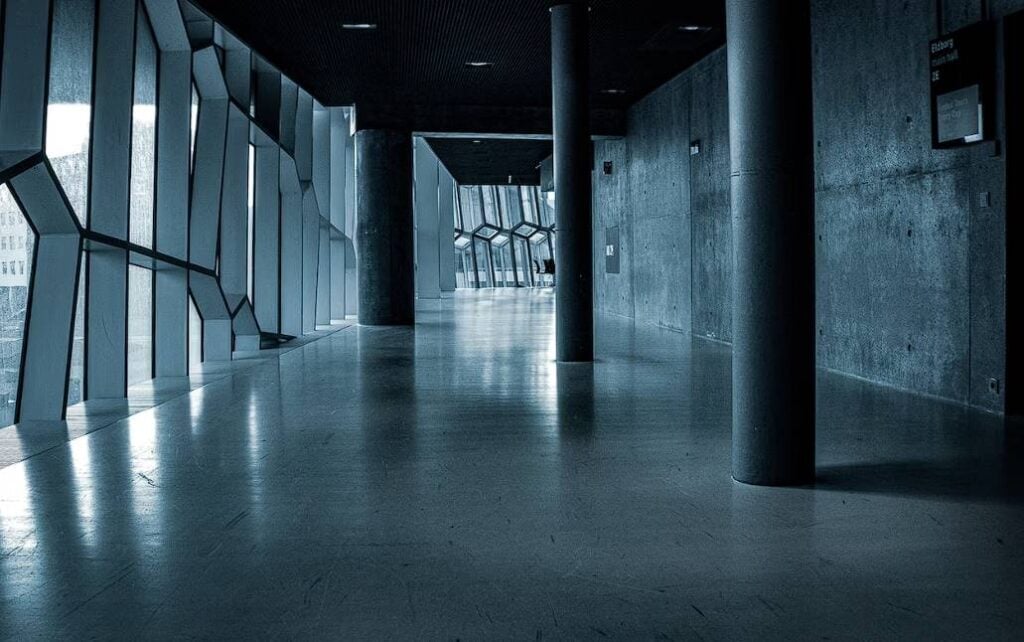When it comes to selecting flooring for areas with high foot traffic, finding the right option can be a daunting task. Finding a flooring material that can withstand heavy use, spills, and stains while maintaining an appealing aesthetic is essential. One option worth considering is poly aspartic flake flooring.
Polyaspartic coatings are polymer coatings renowned for their durability and rapid curing time. Combined with decorative flakes, they create a distinctive and visually appealing flooring solution that is well-suited for high-traffic environments such as garages, warehouses, and commercial spaces.
In contrast to conventional floor coverings, these robust and stain-resistant floors are available in a wide range of styles and colours, allowing you to elevate your interior design and make a lasting impression. However, like any other product, there are advantages and disadvantages to be aware of.
This comprehensive guide explores the benefits and drawbacks of incorporating poly-aspartic flooring into your home or garage, empowering you to make an informed decision regarding its inclusion in your remodelling plans. It's important to carefully weigh these factors to ensure that poly aspartic flake flooring aligns with your specific requirements and preferences.
What Is Polyaspartic Flooring?
Polyaspartic flooring is a unique high-performance system known for its remarkable durability and strength. This flooring option surpasses epoxy in terms of strength and reliability.
The poly aspartic flooring system is an advanced coating system consisting of two components combined and applied as a single layer. It offers impressive resistance to various elements and substances, including:
- Chemicals
- Impact
- UV exposure
- Abrasion
- Heat
Polyaspartic coatings provide exceptional durability and exhibit excellent colour retention, ensuring a visually appealing appearance for many years. Furthermore, these coatings offer slip resistance, promote a safer environment, and have low VOC emissions, contributing to better indoor air quality.
One of the advantages of polyaspartic flooring is its application versatility. With minimal preparation, it can be applied over various substrates such as concrete, steel, or wood, providing flexibility in installation options.
It is important to note that poly-aspartic coatings offer a highly durable surface but are not completely immune to damage. However, they are more cost-effective and easier to clean than traditional coatings. Therefore, considering individual needs and requirements is crucial when determining if poly aspartic flooring is ideal for a specific project.
When to Install Polyaspartic Floor Coatings
Polyaspartic floor coatings are a fantastic choice for individuals seeking to enhance the appearance and durability of their floors. These coatings are commonly utilised in commercial and residential settings due to their exceptional protection and efficient application process.
The durability of polyaspartic coatings makes them well-suited for high-traffic areas that experience heavy use, as they can withstand extreme temperatures and endure heavy footfall. In addition, they require minimal maintenance, particularly appealing to businesses seeking an easy-to-care-for flooring solution. Moreover, the glossy finish of polyaspartic coatings adds an attractive aesthetic to residential spaces, and their easy-to-clean nature makes them a practical choice. They also offer slip resistance when installed correctly, making them suitable for areas prone to water exposure.
In summary, polyaspartic floor coatings are an excellent option for those desiring a glossy and long-lasting finish for their floors. They are particularly advantageous for businesses such as restaurants and warehouses that require a durable flooring solution. Additionally, homeowners seeking to elevate the appearance of their floors without significant time or financial investment will find polyaspartic coatings an appealing alternative to more extensive flooring options.
Overview of Pros and Cons
As with all flooring options, there are pros and cons (especially one as costly as a custom polyaspartic floor coating). Polyaspartic floor coatings are more expensive overall than epoxy floor coatings but come with advantages like higher durability, heat resistance, and UV resistance.
Contrarily, polyaspartic floor coatings are frequently more difficult to install, more expensive, and resistant to the corrosive acids found in car batteries. But keep in mind that each choice has a specific application; while a polyaspartic coating might be advantageous in some areas, it might not be in others. So let's get into some more detailed benefits and drawbacks.
Pros of Polyaspartic Flooring:
Durability
Polyaspartic coatings are highly durable, can withstand the rigours of heavy foot traffic, and resist spills and stains. Their exceptional durability extends to resistance against abrasions and impacts, making them an excellent choice for areas that experience high levels of activity and use. Whether in a commercial space or a busy household, polyaspartic coatings provide reliable protection against the wear and tear associated with daily foot traffic, ensuring that the floors maintain their quality and appearance for an extended period.
Fast Drying
Polyaspartic floor coatings offer rapid installation and curing due to several factors. First, the unique poly aspartic co-polymer chemistry enables a swift and straightforward application process. The coating material can be easily applied in multiple layers using a roller or brush, and it has the advantage of curing quickly, often within a few hours.
Furthermore, polyaspartic coatings are typically formulated with a low VOC (volatile organic compound) solvent system, contributing to shorter drying times between coats. In addition, these coatings are designed with specific curing agents that accelerate the curing process. Combining a low VOC solvent system and specialised curing agents allows the material to cure rapidly, resulting in efficient installation and quick cure times. This means that the coated area can be ready for use in a relatively short period, minimising downtime and allowing for a faster turnaround.
UV Resistant
Polyaspartic floor coatings have excellent UV resistance, ensuring they maintain their colour and appearance over an extended period, even when exposed to prolonged sunlight. This resistance to UV rays prevents fading or discolouration, providing long-lasting durability and aesthetic appeal. In addition, regardless of how much sunlight the coating is subjected to, it will remain vibrant and unaffected by UV-induced damage.
Resistant to Chemicals and Abrasion
Polyaspartic floor coatings exhibit exceptional resistance to chemicals and abrasion thanks to the unique chemical composition of the product. The primary component, an aliphatic amine-terminated polyurea, forms a highly cross-linked polymer that imparts remarkable durability and protection against abrasion and chemical deterioration.
Furthermore, these coatings boast remarkable UV resistance, effectively shielding the floor from the damaging effects of sunlight. This UV resistance ensures the coating maintains its vibrant appearance and resists fading or discolouration over time. Additionally, the high gloss finish of the coating contributes to its resistance against wear and tear, further enhancing its longevity and performance.
Attractive
Polyaspartic flake flooring offers various customisation options to suit your preferences. You can choose from various decorative flakes and colours, allowing you to create a truly personalised and visually appealing flooring solution that perfectly complements your space. This customisation feature ensures that your poly aspartic flake flooring stands out and adds a unique touch to your environment, reflecting your style and enhancing the overall aesthetic appeal of the space.
Less Offensive Odor Than Other Floor Coatings
Due to their reduced VOC content, polyaspartic floor coatings have a lower odour than other floor coatings. These coatings are specifically formulated to minimise the release of volatile organic compounds (VOCs), which helps to minimise the associated strong smell.
The reduced odour of polyaspartic coatings improves the overall indoor air quality and makes them a more environmentally friendly choice. Therefore, these coatings have a lower potential to contribute to air pollution and are considered more eco-friendly.
Moreover, the quick-drying nature of polyaspartic coatings eliminates the need for complex ventilation systems, making them a convenient option for homeowners and business owners with smaller spaces. The faster drying time also reduces the inconvenience of long drying periods, allowing quicker access to the coated area.
In summary, the lower odour and reduced VOC content of polyaspartic floor coatings make them a more environmentally friendly and convenient option for both residential and commercial applications.
Cons of Polyaspartic Floor Coatings
Although poly-aspartic flooring has a few drawbacks, it is important to mention some potential disadvantages.
Limited Color Options
Polyaspartic coatings may have a limitation regarding colour variety compared to epoxy floor coatings. However, they are typically available in light and medium shades of grey due to the impact of pigments on the curing process of polyaspartic blends. This can result in a less extensive range of colours than epoxy flooring.
In contrast, epoxy flooring offers a wider selection of colours and hues, allowing for more customisation to match the personal style or existing decor. The longer curing time of epoxy coatings also enables the inclusion of a greater variety of pigments without compromising effectiveness.
While polyaspartic coatings offer the advantage of quick and durable surface application, it is important to note that some companies may have limited colour options. This could be a drawback for individuals seeking a more personalised flooring solution.
Cost
While poly aspartic flake flooring may come with a higher price tag than other options, such as epoxy or polished concrete, it is important to consider its long-term benefits and value. The durability and low maintenance nature of poly aspartic flake flooring can make it a worthwhile investment over time.
Although the upfront cost may be higher, the exceptional durability of polyaspartic coatings can result in reduced maintenance and repair expenses in the future. In addition, its resistance to stains, abrasions, and chemicals can contribute to a longer lifespan and a flooring surface that retains its quality and appearance over time.
Furthermore, the low maintenance requirements of poly aspartic flake flooring can save time and money in the long run. With minimal upkeep and easy cleaning, the need for costly and time-consuming maintenance procedures can be significantly reduced.
Therefore, while poly aspartic flake flooring may have a higher initial cost than other options, its durability and low maintenance characteristics can make it a worthwhile investment in the long term.
Vulnerable to Acid Corrosion
Polyaspartic floor coatings are susceptible to corrosion when exposed to highly acidic compounds. The chemical composition of polyaspartic coatings, which consists of weakly bonded amino acid molecules, makes them susceptible to breakdown in the presence of acids.
When the bonds between the amino acid molecules are disrupted, the coating loses its ability to form a stable film, compromising its protective properties. Acidic substances can then permeate the coating, leading to potential corrosion and staining of the underlying substrate. This can result in structural weakening and aesthetic damage to the flooring.
It is essential to ensure that the substrate is properly sealed and protected to prevent such issues. Additionally, neutralising acids before they come into contact with the polyaspartic coating can help mitigate the risk of corrosion and maintain the longevity of the flooring system. Proper precautions and maintenance should be taken to safeguard against acid-induced damage in poly aspartic floor coatings.
Slippery
Concerns have been raised about the slipperiness of polyaspartic flooring when wet, and it is important to acknowledge this issue. However, it is crucial to note that the installation process plays a significant role in determining the slip resistance of the flooring.
To address this concern, it is recommended to incorporate anti-slip additives during the installation. These additives help enhance the floor's texture, providing better traction and grip, especially when the surface is wet. This is particularly crucial in residential settings where safety is paramount. In addition, anti-slip additives can significantly improve the practicality of polyaspartic flooring in areas prone to liquid spills, as they enhance traction and reduce the likelihood of slips and falls. Therefore, selecting a knowledgeable and experienced installer who incorporates anti-slip measures is essential for ensuring the safety and usability of polyaspartic flooring.
It Can't Be Installed When High Moisture Is Present
Polyaspartic floor coatings are not suitable for installation in areas with moisture as they can negatively impact the performance and installation quality. Moisture can cause the coating to become soft and fail to adhere properly to the floor surface. This can result in bubbling and lifting of the coating, leading to an unsatisfactory outcome.
Furthermore, high moisture levels can significantly prolong the curing process of the coating, resulting in a suboptimal finished product. Therefore, to ensure a successful installation, addressing any existing moisture issues before applying the polyaspartic floor coating is crucial. This may involve resolving water intrusion problems or allowing the area to dry thoroughly before proceeding with the coating application. These precautions can minimise the risk of coating failure and compromised durability, leading to a more reliable and long-lasting flooring solution.
Pros and Cons of a Polyaspartic Floor: Is It Worth It?
So, is poly aspartic flooring a worthwhile choice? We believe it is.
Polyaspartic flooring surpasses other options due to its exceptional durability and ability to resist scratches, stains, and chemicals. It also boasts low-maintenance requirements, as simple cleaning with a damp mop is sufficient, making it an excellent option for busy commercial spaces and households.
An added advantage is its quick installation process and seamless finish. This makes it particularly suitable for homeowners and garage owners seeking a floor covering that possesses the following qualities:
- Low-maintenance
- Attractive
- Efficient
The primary downside is the higher initial expense. Nevertheless, its longevity, energy efficiency, and low maintenance costs justify it as a smart investment. As mentioned previously, the long-term savings compensate for the initial outlay.
Furthermore, polyaspartic coating outperforms traditional flooring options such as concrete and epoxy in terms of durability, resistance to sunlight, extreme temperatures, and chemical exposure. In conclusion, polyaspartic floors offer a superior flooring solution that businesses and homeowners should seriously consider.
Conclusion
Polyaspartic floor coatings are a type of polymer coating that has gained popularity due to its long lifespan and short curing time. They work well in high-traffic areas like garages, warehouses, and commercial buildings when combined with decorative flakes to make a unique and aesthetically pleasing flooring solution. When considering installing poly-aspartic flooring in your home or garage, there are benefits and drawbacks to think about. Polyaspartic flooring is an innovative coating technology that consists of two components applied as a single layer, providing exceptional resistance to a wide range of environmental and chemical factors. Compared to conventional coatings, it saves money and is simpler to maintain.
Whether or not poly aspartic flooring is suitable for a given undertaking depends on a number of factors, including the unique needs and requirements of the undertaking in question. Commercial and residential properties alike have found success with polyaspartic floor coverings because to its high level of protection and ease of installation. They are long-lasting, resistant to wear and tear from heavy foot traffic, and easy to clean. When put properly, they also provide slip resistance and are simple to clean. Polyaspartic flooring is long-lasting, resistant to heat and ultraviolet light, and dries quickly.
Difficulty in installation, higher cost, and inability to withstand the corrosive acids in automotive batteries are all drawbacks. Installing a polyaspartic floor coating is a breeze because it contains a low VOC solvent solution and special curing agents that speed up the curing process. Their low volatile organic compound (VOC) concentration means they emit less of an odour than conventional floor coatings while still providing great UV protection, chemical and abrasion resistance, a high gloss finish, and plenty of room for personalisation. Even after extended exposure to sunshine, these coatings maintain their durability and attractiveness. Since polyaspartic floor coatings emit less of a chemical aroma and contain fewer volatile organic compounds, they are a better option for the planet.
There are, however, certain limitations, such as a smaller colour palette and a higher retail price. Although polyaspartic flake flooring is more expensive than some alternatives, it is well worth the money because of its long lifespan and little upkeep requirements. It can also have a longer lifespan and keep its quality and look over time if it is stain-, abrasion-, and chemical-resistant. Because of its longevity and ease of care, poly aspartic flake flooring is a good buy. When exposed to strongly acidic substances, it can corrode, hence it's crucial to keep the substrate well-protected.
Improve the floor's texture and safeguard against slips and falls by including anti-slip ingredients in the mix. Because of the coating's softness and poor adhesion to the floor surface, bubbling and lifting are inevitable in high-humidity areas, making them unsuitable for installation. Polyaspartic flooring is a good option because it is scratch-, stain-, and chemical-resistant and lasts for a long time. It's ideal for high-traffic residential and commercial settings thanks to its durability and inexpensive upkeep. The greater purchase price is the biggest drawback, but the product's durability, effectiveness, and ease of maintenance make it a worthwhile investment overall.
Content Summary
- Polyaspartic floor coatings are durable and can withstand heavy foot traffic, spills, and stains.
- They create a visually appealing flooring solution for high-traffic environments.
- Polyaspartic coatings offer a wide range of styles and colors for interior design.
- They are easy to clean and maintain compared to traditional coatings.
- Polyaspartic flooring is known for its remarkable durability and strength.
- It surpasses epoxy in terms of strength and reliability.
- It offers resistance to chemicals, impact, UV exposure, abrasion, and heat.
- Polyaspartic coatings have low VOC emissions, promoting better indoor air quality.
- They can be applied over various substrates like concrete, steel, or wood.
- Polyaspartic coatings are not completely immune to damage but are more cost-effective to clean than traditional coatings.
- They are suitable for areas with high foot traffic and heavy use.
- Polyaspartic coatings require minimal maintenance, making them appealing for businesses.
- They have a glossy finish that adds an attractive aesthetic to residential spaces.
- Polyaspartic coatings offer slip resistance when installed correctly.
- They are an excellent option for garages, restaurants, and warehouses.
- Polyaspartic floor coatings are more expensive than epoxy coatings but offer higher durability, heat resistance, and UV resistance.
- They have a fast drying time, often within a few hours.
- Polyaspartic coatings maintain their color and appearance over time due to excellent UV resistance.
- They are resistant to chemicals and abrasion.
- Polyaspartic flake flooring offers customization options with decorative flakes and colors.
- They have a lower odor and reduced VOC content compared to other floor coatings.
- Polyaspartic coatings are environmentally friendly and convenient for small spaces.
- Limited color options compared to epoxy coatings.
- Polyaspartic coatings have a higher upfront cost but offer long-term benefits and value.
- They are vulnerable to acid corrosion and require proper sealing and maintenance.
- Concerns about slipperiness when wet, but anti-slip additives can be incorporated during installation.
- Polyaspartic floor coatings cannot be installed in areas with high moisture.
- The installation process plays a significant role in determining the slip resistance of the flooring.
- Polyaspartic flooring is low-maintenance, attractive, and efficient.
- Despite the higher initial expense, polyaspartic flooring is a smart investment due to its durability and low maintenance costs.
Frequently Asked Questions
Causes skin and eye irritation. It may cause skin sensitisation and an allergic reaction, which becomes evident on reexposure to this material. It may cause respiratory irritation. Causes skin irritation.
Polyaspartic has superior elasticity compared to epoxy, which is more brittle. How much better? A lot. High-quality polyaspartic coatings are 98-100% more flexible than epoxy coatings.
It is stain resistant to those tough mechanical greases such as brake fluid and oil, meaning you only need to spot clean and sweep as necessary. Although a polyaspartic floor coating may cost more than DIY options, it's worth the price range because of its quality and ability to outshine other floor options.
Though polyaspartic floors can be slippery when wet, anti-slip additives can increase texture, increasing grip. Due to its durability and anti-slip additives, polyaspartic is excellent for residential floor coating.
Polyurea and polyaspartic coatings are highly durable and long-lasting. So if you are looking for a concrete coating that you won't have to worry about maintaining and that will last as long as you live in your home, then this type of coating may be what you're looking for.
